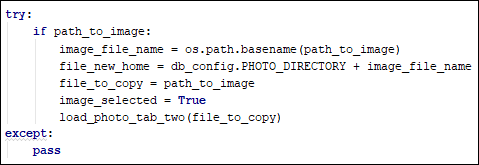

- #Continuously read and copy log file python install#
- #Continuously read and copy log file python full#
When the last log backup is restored, the Database Engine then uses the log information to roll back all transactions that were not complete at that point.
#Continuously read and copy log file python full#
You first restore the last full database backup and the last differential database backup, and then restore the subsequent sequence of the transaction log backups to the point of failure.Īs you restore each log backup, the Database Engine reapplies all the modifications recorded in the log to roll forward all the transactions. Rolling a restored database, file, filegroup, or page forward to the point of failureĪfter a hardware loss or disk failure affecting the database files, you can restore the database to the point of failure. For more information, see Restore and Recovery Overview (SQL Server). Every incomplete transaction found in the transaction log is then rolled back to make sure the integrity of the database is preserved. Every modification recorded in the log that may not have been written to the data files is rolled forward. When an instance of SQL Server is started, it runs a recovery of each database.

If a server fails, the databases may be left in a state where some modifications were never written from the buffer cache to the data files, and there may be some modifications from incomplete transactions in the data files. Recovery of all incomplete transactions when SQL Server is started If an application issues a ROLLBACK statement, or if the Database Engine detects an error such as the loss of communication with a client, the log records are used to roll back the modifications made by an incomplete transaction. Supporting high availability and disaster recovery solutions: Always On availability groups, database mirroring, and log shipping.Rolling a restored database, file, filegroup, or page forward to the point of failure.Recovery of all incomplete transactions when SQL Server is started.The transaction log supports the following operations: Operations supported by the transaction log For more information, see Database Checkpoints (SQL Server). The exec-on-change script terminated when I rm'd t.Known good points from which to begin applying transaction logs during database recovery are created by checkpoints. The following output from exec-on-change appeared in console B: At Thu Aug 16 11:57:: The following output from cat t appeared in console A: Thu Aug 16 11:57: In two consoles I entered commands as follows (where A> means entry in console A, and B> means entry in console B.) A> rm t touch t While S=$(inotifywait -eMODIFY $F 2>/dev/null) # Result of inotifywait is put in S so it doesn't echo # When it changes, do command specified by other params. # Detect when file named by param $1 changes. Here's the example script, called exec-on-change: #!/bin/sh
#Continuously read and copy log file python install#
You may need to install the inotify-tools package, for example via sudo apt-get install inotify-tools. See man inotifywait for other event names and switches.

When I need to detect file changes and do something other than what tail -f filename does, I've used inotifywait in a script to detect the change and act upon it.


 0 kommentar(er)
0 kommentar(er)
